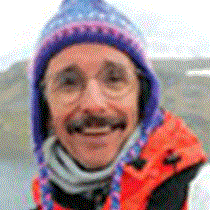Port Lockroy, Paradise Bay & Cuverville Island, Antarctic Peninsula
The clouds retreated. The sun appeared. The sea sparkled. All of Antarctica seemed to smile, with ice and rock standing in bold relief against a stunning blue sky. One hundred gentoos raised their heads in nesting exaltation, then lowered themselves to feed small chicks. We walked past, only a few feet away, to climb the wooden ramp into Bransfield House, a historic throwback to the 1940s when the British arrived in Port Lockroy as part of a secret military affair called Operation Tabarin. The hut fell into disrepair from 1962 until 1996, when the British Antarctic Heritage Trust adopted it, and jazzed it up into the museum and gift shop it is today, the most heavily visited site on the Antarctic Peninsula. We hit the gift shop, perused the museum and had a nice time visiting with the summer staff: Rick, Graham and Mary. Others among us spent a good part of the morning in kayaks, paddling waters so clear we could see thirty feet to the bottom.
Lunchtime found us northbound up the Neumayer Channel. We skirted through Paradise Bay, with a good view of the Chilean research base Gonzalez Videla to starboard. By mid-afternoon we arrived off Cuverville Island, our last stop. For many, we drank in the silence as much as the scenery. A climb to a promontory gave a grand view of the Danco Coast, garnished with large icebergs, and beyond them, our ship. How small it appeared, and even more so as we cruised by Zodiac to find a magnificently arched iceberg that framed the ship in the distance.
Now for the long run home, followed by petrels. And the task of telling family and friends about what we've seen, if that's possible. Samuel Johnson was right when he said, "If a person has experienced the inexpressible, he or she is under no obligation to express it."
The clouds retreated. The sun appeared. The sea sparkled. All of Antarctica seemed to smile, with ice and rock standing in bold relief against a stunning blue sky. One hundred gentoos raised their heads in nesting exaltation, then lowered themselves to feed small chicks. We walked past, only a few feet away, to climb the wooden ramp into Bransfield House, a historic throwback to the 1940s when the British arrived in Port Lockroy as part of a secret military affair called Operation Tabarin. The hut fell into disrepair from 1962 until 1996, when the British Antarctic Heritage Trust adopted it, and jazzed it up into the museum and gift shop it is today, the most heavily visited site on the Antarctic Peninsula. We hit the gift shop, perused the museum and had a nice time visiting with the summer staff: Rick, Graham and Mary. Others among us spent a good part of the morning in kayaks, paddling waters so clear we could see thirty feet to the bottom.
Lunchtime found us northbound up the Neumayer Channel. We skirted through Paradise Bay, with a good view of the Chilean research base Gonzalez Videla to starboard. By mid-afternoon we arrived off Cuverville Island, our last stop. For many, we drank in the silence as much as the scenery. A climb to a promontory gave a grand view of the Danco Coast, garnished with large icebergs, and beyond them, our ship. How small it appeared, and even more so as we cruised by Zodiac to find a magnificently arched iceberg that framed the ship in the distance.
Now for the long run home, followed by petrels. And the task of telling family and friends about what we've seen, if that's possible. Samuel Johnson was right when he said, "If a person has experienced the inexpressible, he or she is under no obligation to express it."




